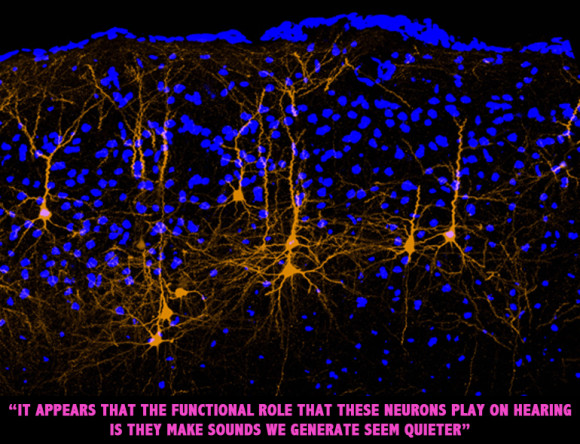
During a normal conversation, your brain is constantly adjusting the volume to soften the sound of your own voice and boost the voices of others in the room.
This ability to distinguish between the sounds generated from your own movements and those coming from the outside world is important not only for catching up on water cooler gossip, but also for learning how to speak or play a musical instrument.
Now, researchers have developed the first diagram of the brain circuitry that enables this complex interplay between the motor system and the auditory system to occur.

The research, published in The Journal of Neuroscience, could lend insight into schizophrenia and mood disorders that arise when this circuitry goes awry and individuals hear voices other people do not hear.
“Our finding is important because it provides the blueprint for understanding how the brain communicates with itself, and how that communication can break down to cause disease,” says Richard Mooney, senior author of the study and professor of neurobiology at Duke University School of Medicine.
“Normally, motor regions would warn auditory regions that they are making a command to speak, so be prepared for a sound. But in psychosis, you can no longer distinguish between the activity in your motor system and somebody else’s, and you think the sounds coming from within your own brain are external.”
Researchers have long surmised that the neuronal circuitry conveying movement—to voice an opinion or hit a piano key—also feeds into the wiring that senses sound.
But the nature of the nerve cells that provided that input, and how they functionally interacted to help the brain anticipate the impending sound, was not known.
M2 Connection
In this study, Mooney used a technology created by Fan Wang, associate professor of cell biology, to trace all of the inputs into the auditory cortex—the sound interpreting region of the brain. Though the researchers found that a number of different areas of the brain fed into the auditory cortex, they were most interested in one region called the secondary motor cortex, or M2, because it is responsible for sending motor signals directly into the brain stem and the spinal cord.
“That suggests these neurons are providing a copy of the motor command directly to the auditory system,” says David M. Schneider, co-lead author of the study and a postdoctoral fellow in Mooney’s lab. “In other words, they send a signal that says ‘move,’ but they also send a signal to the auditory system saying ‘I am going to move.’”
Having discovered this connection, the researchers then explored what type of influence this interaction was having on auditory processing or hearing. They took slices of brain tissue from mice and specifically manipulated the neurons that led from the M2 region to the auditory cortex. The researchers found that stimulating those neurons actually dampened the activity of the auditory cortex.
“It jibed nicely with our expectations,” says Anders Nelson, co-lead author of the study and a graduate student in Mooney’s lab. “It is the brain’s way of muting or suppressing the sounds that come from our own actions.”
In motion?
Finally, the researchers tested this circuitry in live animals, artificially turning on the motor neurons in anesthetized mice and then looking to see how the auditory cortex responded.
Mice usually sing to each other through a kind of song called ultrasonic vocalizations, which are too high-pitched for a human to hear. The researchers played back these ultrasonic vocalizations to the mice after they had activated the motor cortex and found that the neurons became much less responsive to the sounds.
“It appears that the functional role that these neurons play on hearing is they make sounds we generate seem quieter,” says Mooney. “The question we now want to know is if this is the mechanism that is being used when an animal is actually moving. That is the missing link, and the subject of our ongoing experiments.”
Once the researchers have pinned down the basics of the circuitry, they could begin to investigate whether altering this circuitry could induce auditory hallucinations or perhaps even take them away in models of schizophrenia.
The National Institutes of Health supported the study.











